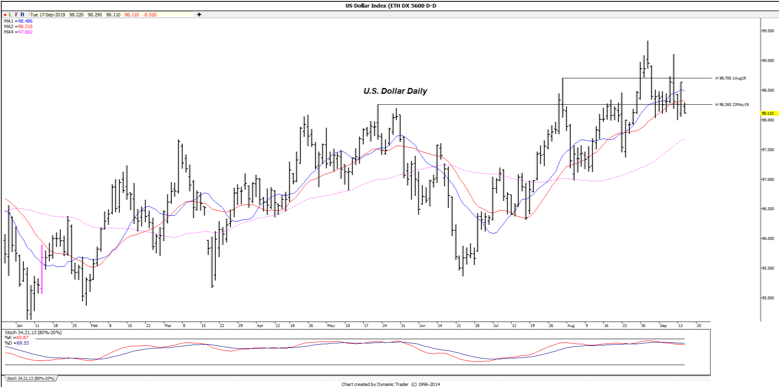By: Dan Hueber –
If you are a reader of this letter on a regular basis, you already know that I find it nonsensical that some in the trade appear to be hyper-focused on the minor changes in crop rating each week instead of taking a broader look at the overall picture and pattern. This appears to be on display again overnight as we have seen prices turn lower because…wait for it…because crop ratings did not deteriorate as expected. Now, I recognize that the softer prices could really be more about taking a breather after three to four days of higher closes or even that with no escalation in attacks in Saudi Arabia, the crude market has calmed down a bit, but I guess that does not sound like as good of a reason. Obviously, the rationale is, crop ratings are semi-stable so that must mean it is healthier than we thought, and hence, the yield will be higher than we thought. As I said, this would seem nonsensical, particularly considering that at this time of year, a lower rating is more a reflection of crop maturing than anything else, which makes the 1% drop in bean very understandable and in the case of corn, the extreme late planting this year would translate into crops maturing at a later than normal date and hence, rating would not be slipping quite as soon. Of course, that required a rationale look at this growing season, and when you are programmed to react to the most immediate news in front of you, that would take entirely too long. Anyway, for many saying the market is lower because conditions a short-term overbought is not a “reason” they can sink their teeth into. Too much ambiguity in that statement even if it is correct.
More sales reported to China this morning. An additional 260,000 MT of beans have been reported, warming up the seats at the negotiating table just a bit more.
As I briefly mentioned previously, the crude oil trade has turned quiet this morning as they wait for additional information on the situation in the Mideast. Of course, the fact that we rallied to the highest levels since spring and are really maintaining that range this morning would seem to speak to the uncertainty that surrounds this situation. Not surprisingly, we also witnessed a sharp reaction higher in the U.S. Dollar yesterday as people raced for the security of this reserve currency, but interestingly enough, we have erased those gains and then some overnight. The dollar continues to act like it wants to turn lower, but so far there have been these periodic scares that bring buyers temporarily rushing in.
While our overall bean export may not be up to par this year, the crush industry is trying to pick up some of the slack. For the second month in a row NOPA, crush numbers have exceeded expectation, and during August we squeezed 168.085 million bushels, well above the average estimate of 162.08 and the 158.885 million crushed a year ago. In July, we crushed 168.093 million. Soy oil stocks actually slipped down to a 21-month low of 1.401 billion pounds, which was also below expectations. If there was a negative take away, meal exports for the month totaled 699,212 tons, 20.5% below the July number of 879,319 and 9.2% below the last year at 761,899.
The hog industry in South Korea is on red alert, no pun intended, as a case of African Swine Fever was confirmed at a farm near the border with North Korea. If you recall, there was an outbreak in the north back in May. The government has immediate take steps to try and contain the disease, including a ban on the movement of hogs for the next 48 hours. Of course, in many nations, the problems have been in containing wild boars that obviously could care less about government regulations. South Korea has a hog population of 11.3 million and also imports pork primarily from the United States and Germany and last year brought in 570,000 MT. Needless to say, if this disease does spread it would be a positive for the U.S. hog industry but not so for the corn and soy markets.
